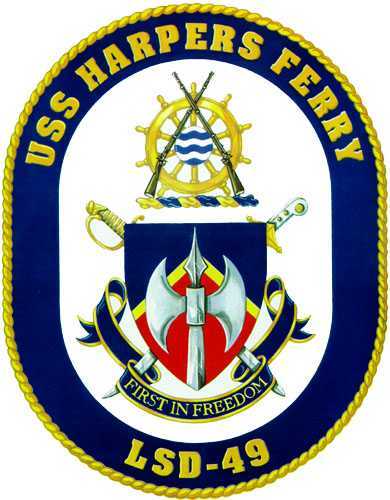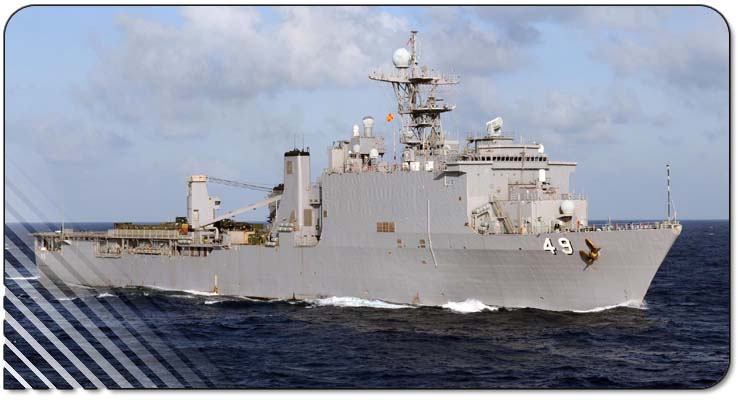Namesake:
Harper's Ferry, WV
Harpers Ferry is a small, residential town (population 423) and tourist
center in the northeastern corner of West Virginia. Nestled in the Blue
Ridge Mountains at the confluence of the Potomac and Shenandoah Rivers,
Harpers Ferry is known for its scenic beauty and historic significance.
Harpers Ferry has forever entrenched itself in the "American Story" as
a place where brave men and women lived, fought, and died for their
ideals.
Settled in 1732, Harpers Ferry is named for Robert Harper, who in 1747
began to operate a ferry across the Potomac River there. In 1796
President George Washington selected Harpers Ferry as the site for a
new United States Arsenal and Armory. Many of the rifles used in the
War of 1812 and American Civil War were manufactured at this armory.
The armory also made the town of Harpers Ferry a logistically strategic
location during the Civil War; coveted by both the North and South.
During the Civil War, Harpers Ferry changed hands between the Union and
Confederacy several times, spilling much American blood on its rocky
soil. In September 1862, Harpers Ferry's capture by the South provided
General Robert E. Lee with a launching point for the Confederate
invasion of Maryland, which ended in the bloody battle of Antietam.
What the town is probably most famous for though, is John Brown's
failed raid on the Harpers Ferry Armory. John Brown, called Old Brown
of Osawatomie (1800-1859), was one of America's most famed
abolitionists. Brown's attempts to end slavery by force greatly
increased tension between North and South in the period before the
American Civil War.
Brown was born on May 9, 1800, in Torrington, Connecticut. His family
moved to Ohio when he was five-years-old. John Brown acquired a hatred
of slavery that marked his subsequent career, with his father having
been actively hostile to the institution. John Brown initiated a
project among sympathetic abolitionists to educate young blacks in
Pennsylvania, where he was then living. The next 20 years of his life
were largely dedicated to this and similar abolitionist ventures.
Aided by increased financial support from abolitionists in the
northeastern states, Brown began in 1857 to formulate a plan, which he
had long entertained, to free the slaves by armed force. He secretly
recruited a small band of supporters for this project, which included
the establishment of a refuge for fugitive slaves in the mountains of
Virginia. After several setbacks, he finally launched the venture on
October 16, 1859, with a force of 18 men (including several of his
sons), seizing the U.S. Arsenal at Harpers Ferry, and winning control
of the town.
After his initial success he made no attempt at offensive action, but
instead occupied defensive positions within the arsenal. His force was
soon surrounded by the local militia, which was reinforced on October
17 by a company of U.S. Marines under the command of Colonel Robert E.
Lee. Ten of Brown's men, including two of his sons, were killed in the
ensuing battle, and he was wounded and forced to capitulate. He was
arrested and charged with various crimes, including treason and murder.
Convicted, he was hanged on December 2, 1859 at Charlestown, West
Virginia.
Today Harpers Ferry is hardly the torrid site of bloodshed and struggle
it was in the 19th century. Harpers Ferry is now a National Historical
Park, visited by thousands of tourists every year. The town includes
many old structures restored as museums and shops. Harpers Ferry is
also home to several buildings of Storer College, a Freedman's Bureau
School opened in 1867 to educate former slaves.
|
Ship's Crest:
 Supporters:The
Navy and Marine Corps officer's swords reflect the ship's mission and
are crossed to denote cooperation, teamwork, and strength. Supporters:The
Navy and Marine Corps officer's swords reflect the ship's mission and
are crossed to denote cooperation, teamwork, and strength.
The Shield: Dark blue and gold are
the colors
traditionally associated with the Navy and symbolize the sea and the
excellence. Red and gold are the traditional Marine Corps colors. The
chevron denotes movement, symbolizing the delivery ashore of ground
troops. The battle axe denotes strength and battle readiness, has two
cutting edges to allude to the prowess of both HARPERS FERRY and the
Marines she will land.
The Crest: The ship wheel and the
fountain,
heraldic symbols for the water, refer to worldwide capabilities and
transportation while highlighting the location and importance of the
town of Harpers Ferry, West Virginia, the ship's namesake. The muskets,
from the Civil War era indicate both the past and present Harpers
Ferry, while alluding to the history of the town.
Motto: "First in Freedom"
|

